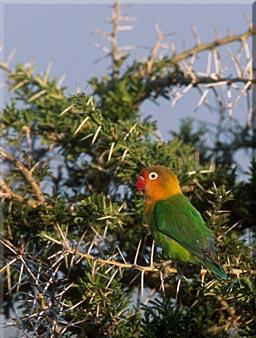Lovebird - Fischer's
Fischers Lovebird Scientific Name: Agapornis personata fischeri
Sat, 5th July, 2025 - 9:19 pm GMT
Sponsor Ads:

Alternative Name
Fischers Lovebird Scientific Name: Agapornis personata fischeriBasic Info
The Fischer's Lovebird comes in a wide variety of color mutations including, Albino, Pied, Black or Dark Eyed White, Dilute Blue, Dilute Yellow, Lutino, and Cinnamon. Fischer's Lovebirds are classified with four other distinct species as 'Eye-ring Lovebirds' (The other three species are Black Cheeked, Masked and Nyasa). This classification is readily apparent, as the Fischer's Lovebird possesses a white eye ring that is not existent in other breeds such as the Peach Faced Lovebird. The Fischer's Lovebird is much smaller than other parrot species measuring only five to six and a half inches at adulthood.
Health
Like other Lovebirds the Fischer's Lovebird requires a proper cage, preferably not bamboo or wood since these can be chewed, causing the cage to become unsafe. These birds love toys and should be provided plenty of them. In addition several perches are also recommended. Some favorites include, rope ladders, bells and natural wood perches. Mirrors, however, are not recommended as many state that they are harmful for the psyches. The Fischer's Lovebird also does quite well in flight aviaries. Breeding The Fischer's Lovebird is regularly bred in captivity. Females will lay three to six eggs with an incubation period ranging from 20 to 26 days. It should be noted that Fischer's Lovebirds mate for life.Habitat
N/ABehavior
The Fischer's Lovebird can be described simply as beautiful. With their natural warm hues the Fishers Lovebird is sure to capture your heart. It is no surprise that the Fischer's Lovebird is one of the most loved Lovebirds raised in captivity today. The Fischer's Lovebird (also called the Fischers Lovebird) is not only handsome, but he is playful, energetic and fun to be around. In addition the Fischer's Lovebird is easy to tame, and bonds easily with his owners. This is particularly true if you buy a young handraised bird. Unlike many of the other parrot species, Fischer's Lovebirds are relatively quiet and will not cause the complaints larger parrots often draw from neighbors and housemates. In addition the cost of a Fischer's Lovebird is minimal when compared so some other parrots. The Fischer's Love bird is also easier to house and care for because of their small size. Lovebirds in general are not know for talking ability; the Fischer is no exception. If you want a bird that has talking ability you should select another breed. On occasion some Fischer's Lovebirds have been taught a couple words to mimic, but this is not the norm and should not be expected. Some refer to the Fischer's Lovebird as 'clowns'. This is because they are such energetic playful creatures. They bounce around their environments from perch to toy, to toy and back to their perch again, exhibiting almost tireless energy.Origin
AfricaHistory
The Fischer's Lovebird originates in Africa and nearby Islands.Common Foods
N/ASponsor Ads:
"Perhaps when one wishes to prove something, one ought not to employ illustrations that are not manifest, but to illustrate the obscure by the manifest, and the things of mind by the things of sense; for the latter are more manifest." -- Aristotle. Magna Moralia.
Lovebird - Fischer's
Coded by: BGID® | ALL RIGHTS RESERVED Copyright © 2000-2025
Disclaimer | Privacy | Report Errors / Contact | Credits

 Why haven't we as a collective earth met with aliens yet?
Why haven't we as a collective earth met with aliens yet?  World EcoSystem - Biodiversity Changes - Who is on board and who isn
World EcoSystem - Biodiversity Changes - Who is on board and who isn  Homosexual behavior stems from the mind or genetics?
Homosexual behavior stems from the mind or genetics?  The Best Text Adventure You Will Ever Play! The official site:
The Best Text Adventure You Will Ever Play! The official site:  Mouthwash - Mouthrinse - Mouth Sores - Healing Infections - Gingivitis
Mouthwash - Mouthrinse - Mouth Sores - Healing Infections - Gingivitis  Treatment for Depression
Treatment for Depression  Ultra radical and violent Islamist group that even rivals Al Qaeda
Ultra radical and violent Islamist group that even rivals Al Qaeda  An idea to have teachers who want to carry guns to school undergo some level of police training will be left up to local school districts and police departments.
An idea to have teachers who want to carry guns to school undergo some level of police training will be left up to local school districts and police departments.